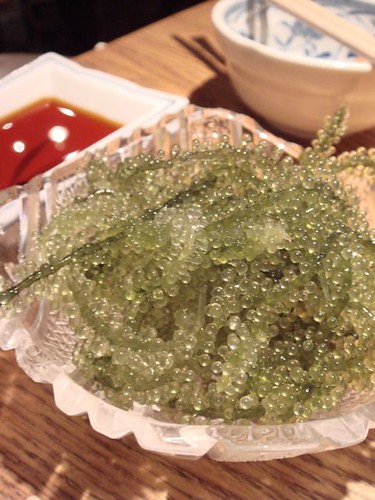
Upon closer inspection, we identified the barista...
...scrunched between the trunk, the roof, and the seat dividers. He also appeared to be the owner, and uncomfortable.

Service at Espresso Bar Madeleine is (not unsurprisingly) laid-back. If there are folks before you, you wait an extra five minutes to get your order in. But who gives, on a Saturday afternoon? If you do, you should not be in Naka-Meguro, period. Go to Shinjuku or something.
Also, Madeleine passed my iced Americano test, which is less like a test and more like a regular order of an iced Americano. (I just said it to sound cool.) Though I will drink a crappy Americano over no Americano any day, I always prefer a well-thought out, lovingly-brewed one, and am willing to pay my way for it. You see, I am from Seattle. (For those of you who get it, go ahead and skip to the next paragraph.) We have Starbucks on every face of a city block and a small business-operated cafe on every outer-city block (that or a Tully's). And most of them know exactly what they're doing. Some people say Starbucks' coffee is overroasted--not me. And I love, especially, the fresh bitterness of an iced Americano, two shots of just-brewed espresso poured over ice and then splashed with ice-cold water. That is a good iced Americano. Starbucks (usually) does it, Javasti does it and, well, almost any other cafe I frequent (-ed) does it right--in Seattle. I can't say the same thing about cafes in Tokyo, but thankfully enough cafes here serve excellent brew. Madeleine included.
I was actually doubly surprised at Madeleine; first by how cold the Madeleine barista was able to get it (I confess--I was expecting it to be luke-warm coming from a car at 2pm in July), and then at the balance of bitterness, sourness and deliciousness the drink provided. But what was even better was my friend's uji matcha latte. First the uji matcha was froathed with milk. Then the espresso was brewed into another cup. Finally, the barista gave my friend both cups and had her pour one into the other.

Pretty awesome! Now, the whole process from Americano to uji matcha completion took about eight minutes and on a Monday morning I'd perhaps border getmemyfrigginlattehomeboy, but this was Saturday afternoon, and Naka-Meguro. So my friend and I were charmed (though she may be on a Monday morning as well). What won me over completely was that the uji matcha foam was not sweetened, as many green-tea latte mixtures can be (tsk, tsk, tsk). He served both our drinks with bite-sized Japanese Meiji chocolates, complementing our coffees. We had a few minutes to chat with the owner and as he never came out of his shop/car, he mustn't have been as uncomfortable as I initially suspected. He's along the Meguro River every day except Mondays, so make sure to stop by next time you're in town.
Apparently the owner/barista bakes/serves extra extra chocolat cookies in the winter time, and something tells me they'll be more rich and dreamy than sugary. Can't wait.
宇治抹茶ラテ Uji matcha latte
明治チョコレートMeiji chocolates
Espresso Bar Madeleine
Along the Meguro River, click here for map
T 090-3500-0560
http://madeleine2.exblog.jp























